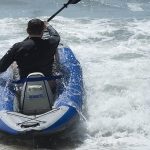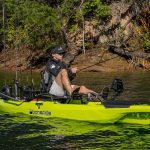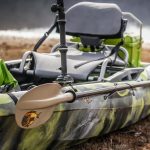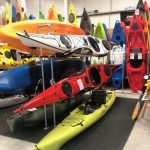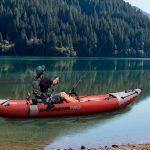Drop stitch technology and heavy-duty materials have made some inflatable kayaks capable even in whitewater. Here's our list of tough whitewater models.

Paddleboarding makes every summer a true delight for me! I get to spend long hours on the water, drifting along with a tasty drink, exploring coves and creeks, or crossing local lakes.
There’s just one problem: to get out on the water, I’ve got to spend a lot of time (and effort) pumping up the paddleboard using the hand pump provided. It’s no fun at all, not to mention tiring enough that I enjoy my paddling just a little bit less.
Then I discovered electric pumps and everything changed…
Electric pumps do all the hard work of inflating your kayak or SUP for you. All you’ve got to do is plug them in and connect the hose and you’re set to go. Quick and beautifully easy!
In this article, I’ll share with you the best electric pumps for inflatable kayaks and SUPs that I’ve put to the test and found to be high quality, reliable, and savvy investments for any water sports enthusiast like me.
As an affiliate of Amazon and other retailers, we may earn a small commission when you buy via our links, at no additional cost to you. Thank you!
At a Glance: Best Electric Pumps for Inflatable Kayaks and SUPs
- Best Overall: TOPUMP 7500 mAh Rechargeable SUP Air Pump
- Budget Pick: OutdoorMaster Dolphin
- Best Compact: Nixy Ventus
- Fastest: BTP Two Stage Electric Turbo Pump
- Best Battery-Powered Alternative: OutdoorMaster Whale
- Most Portable: iRocker Electric Pump
- Most Versatile: OutdoorMaster Shark II
- Honorable Mention: Aquaglide Accelerator
Comparison Table: Best Electric Pumps for Inflatable Kayaks and SUPs
| Model | Specs | Where To Buy |
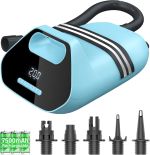 TOPUMP 7500mAh Rechargeable SUP Air Pump | Max PSI: 20 PSI Dimensions: 11.81 x 7.87 x 5.91 inches | Amazon |
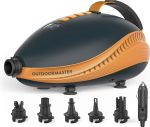 OutdoorMaster Dolphin | Max PSI: 20 PSI Dimensions: 10.23 X 6.29 X 5.11 inches | Amazon |
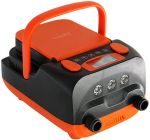 Nixy Ventus | Max PSI: 20 PSI Dimensions: 10 x 8 x 5 inches | Amazon |
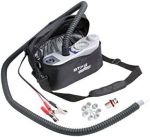 BTP Two Stage Electric Turbo Pump | Max PSI: 14.5 PSI Dimensions: 12 x 4 x 6 inches | Amazon |
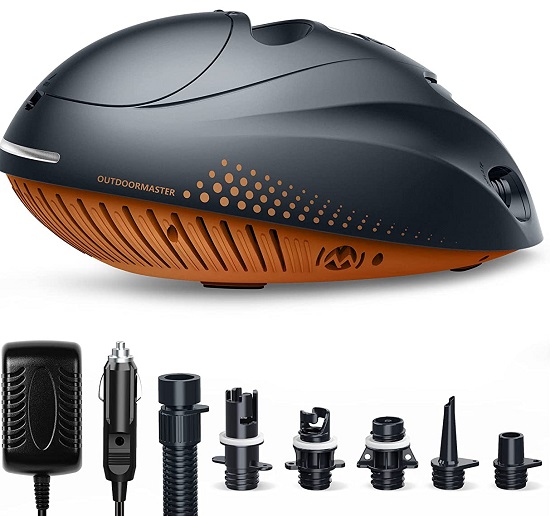 OutdoorMaster Whale | Max PSI: 16 PSI Dimensions: 14.56 x 8.66 x 6.69 inches | Amazon |
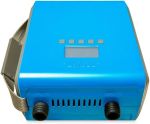 iRocker Electric Pump | Max PSI: 20 PSI Dimensions: 7 x 8.5 x 4 inches | Amazon |
 OutdoorMaster Shark II | Max PSI: 20 PSI Dimensions: 12.48 x 10.55 x 7.24 inches | Amazon |
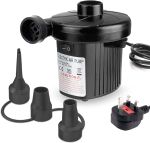 Aquaglide Accelerator | Max PSI: 20 PSI Dimensions: 10.4 x 7.3 x 6.5 inches | Amazon |
The Best Electric Pumps for Inflatable Kayaks and SUPs
Best Overall: TOPUMP 7500 mAh Rechargeable SUP Air Pump
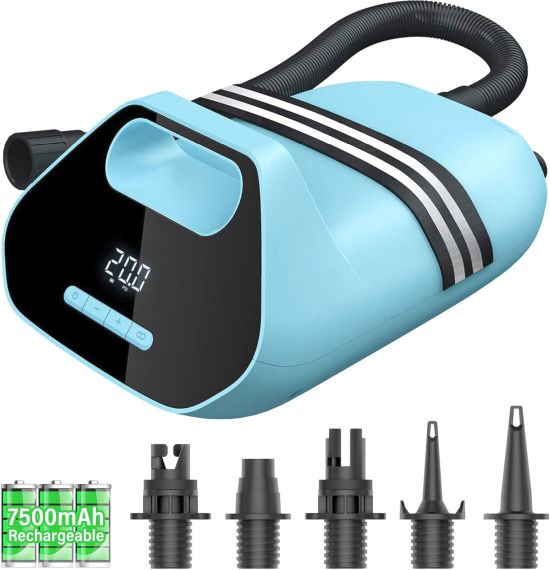
Max PSI: 20 PSI
Power Source: 7500 mAh battery pack, 12V car power, and 110V wall socket
Dimensions: 11.81 x 7.87 x 5.91 inches (30 x 20 x 15 cm)
Warranty: 1 year
I’ve used this pump for months now and I can honestly say I LOVE IT.
First off, I like that it’s battery-powered so I can take it with me when I hike my SUP to a lake or river (which I do often). But it’s also capable of plugging into my car’s 12V power supply for easy convenience. Plus, it even charges with a 110V wall plug so I can keep it topped up at local campgrounds and trailer parks as well as at home.
It’s compact and lightweight enough to be portable but generates more than enough power for what I need. Thanks to the 350L/min Stage I high volume and 85L/min Stage II high pressure output, it takes only roughly eight minutes to get my 10.5-foot board up to 15 PSI. The deflation setting empties the board completely in around a minute.
One feature I really like is the hidden cord design so there’s nothing dangling or getting tangled with my camping gear. It’s also easier to keep it neat and tucked out of the way when not in use.
If I had one complaint, it’s that I can’t use it on grass, dirt, or debris-strewn ground. The lack of an air filter means small debris gets sucked right into it and could burn it out. What I usually do is put the pump on top of my board when inflating to avoid any problems.
Budget Pick: OutdoorMaster Dolphin
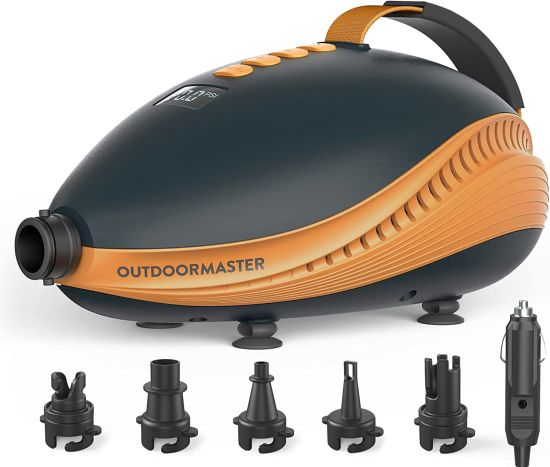
Max PSI: 20 PSI
Power Source: 12V DC car connector
Dimensions: 10.23 X 6.29 X 5.11 inches (26 x 16 x 13 cm)
Warranty: 2 years
For less than half the cost of our best overall pick, this is a pretty great “backup pump” to keep in your gear in case your primary breaks or you’ve got multiple boards to inflate.
Don’t let its small size fool you: it’s compact but powerful, capable of reaching 15 PSI in around 13 minutes per board. Its on-board cooling system will keep it running long enough for you to inflate as many as ten paddleboards without stopping. I really like how quiet it is—at just 70 dB, it’s one of the least noisy of the electric SUP pumps I’ve used to date.
A few more features I found quite handy include: a carry handle, a sunlight-readable digital display with large numbers, a 9-foot cable, and a complete set of nozzles that make it compatible with virtually any inflatable, be it SUP, kayak, or pool toy.
I will say that I don’t like the lack of a carrying case. You might have to repurpose an old backpack to haul it around safely, or like me, just keep it in its box.
The absence of a deflate setting also makes it less versatile than other SUP pumps. Some paddleboards (like the BodyGlove Performer 11) are designed to roll up from the tail-end first, which means all the air needs to be pumped out rather than allowed to drain out naturally as it’s rolled up.
Given the price tag and the 2-year warranty, however, I think it is more than worth the investment.
Best Compact: Nixy Ventus
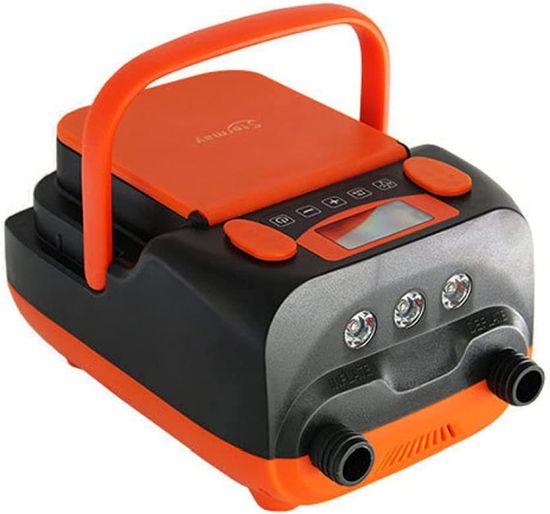
Max PSI: 20 PSI
Power Source: 12V DC car connector (with battery pack available)
Dimensions: 10 x 8 x 5 inches (25.4 x 20.3 x 12.7 cm)
Warranty: 1 year
If you want to keep your camping/paddling gear as minimal as possible, the Nixy Ventus is definitely my top pick. I’ve loved carrying it around with me on my lake and beach trips because I can not only plug it directly into my 12V DC car plug, but also hook it straight up to the car battery (thanks to the provided cables).
The pump has all the features I look for: active cooling tech that keeps it from overheating, the ability to inflate up to three boards back to back, a high-pressure pump capable of hitting 20 PSI, an easy-to-read digital display, an auto shut-off that you can set to whatever PSI you want, a carrying bag, and a full collection of nozzles compatible with all the major valves. I’ve used this pump for years now and have found it to be incredibly reliable as well as wonderfully powerful despite its small size.
My biggest complaint is that it’s slower to inflate than most of the other pumps I tested. It took close to 15 minutes to inflate my 11’6” SUP to 15 PSI, when the OutdoorMaster Dolphin did it in just over 12 minutes and the TOPUMP in 11. It’s a bit lacking in power compared to the other models I’ve reviewed, but it still gets the job done in the end.
Fastest: BTP Two Stage Electric Turbo Pump
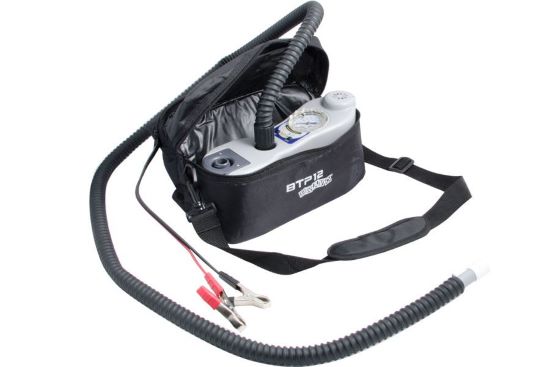
Max PSI: 14.5 PSI
Power Source: 12V DC alligator clips to connect to a 12V DC car battery (can’t connect to a 12V outlet)
Dimensions: 12 x 4 x 6 inches (30.5 x 10.2 x 15.2 cm)
Warranty: Unspecified (many BTP products are backed by a 3-year warranty, but it’s unclear whether this includes the pump)
As soon as I saw the word “Turbo” on this pump, I knew I had to give it a try. And over the course of my tests, it didn’t disappoint. Though it only reached 14.5 PSI, it did so noticeably faster than the other electric pumps I tested.
I wasn’t so fond of the dial that the pump uses to control the air pressure (I much prefer digital controls), but I did like the auto shut-off when the PSI reached its max. I also liked that it’s one of the more compact models on the list—a bit heavy, sure, but easy to pack in my SUP bag or camping gear.
Compared to most of the other pumps I reviewed, it’s on the pricier side. It also doesn’t include any nozzles, meaning it’s only compatible with the Halkey Roberts valve.
Finally, because it draws up to 20 Amps, you can’t connect it to your car’s 12 V outlet. You have to connect it directly to a battery via the included alligator clips.
Still, thanks to its speed, it’s a great choice for larger-volume kayaks or SUPs. It gets the job done and gets you out on the water faster.
Best Battery-Powered Alternative: OutdoorMaster Whale

Max PSI: 16 PSI
Power Source: 6000 mAh lithium ion battery, 12V DC car connector, and 110V wall plug
Dimensions: 14.56 x 8.66 x 6.69 inches (37 cm x 22 cm x 17 cm)
Warranty: 2 years
My top pick, the TOPUMP, is the battery-powered pump I’d recommend most highly. But if it’s not available in your area or sold out and you need a pump today, the OutdoorMaster Whale is a suitable backup plan.
The built-in 6000 mAh lithium-ion battery has enough juice to inflate 3 boards up to 16 PSI. You get rapid fill on Stage I (350L/min), though it’s a bit slower on Stage II (just 70L/min) so it’ll take a bit longer to get it up to maximum inflation (I found around 13 minutes for my 11’6” SUP).
The fact that it’s battery powered is a huge plus for me—I can take it anywhere and use it anytime—but it can also be plugged into your car’s 12V DC power supply as well as hook into a 110V wall plug (at home or a campground) for quick charging and instant power. It’s also got a full collection of five nozzles that make it compatible with all valves, an integrated LED light for use after dark, a USB port charger, and a built-in storage compartment to keep cables and nozzles tidy when not in use.
Aside from the low max PSI and slightly slower filling time, I had no complaints when testing this pump.
Most Portable: iRocker Electric Pump
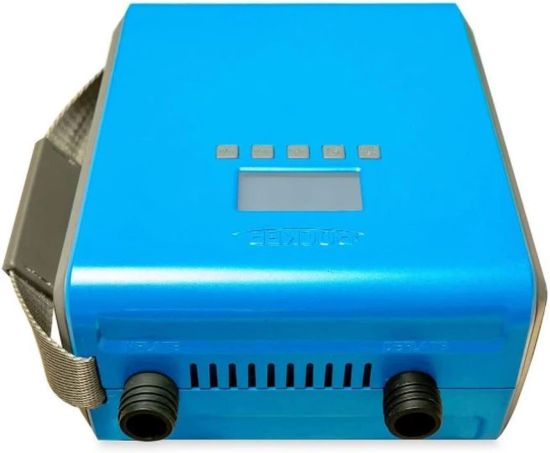
Max PSI: 20 PSI
Power Source: 12V DC car connector (plug alligator clips to connect directly to the car battery)
Dimensions: 7 x 8.5 x 4 inches (17.8 x 21.6 x 10.2 cm)
Warranty: Up to 3 years
I put this iRocker Electric Pump to the test and couldn’t be happier (see my review here). Compared to the Nixy Ventus, I found that its more compact size conceals a more powerful motor than its competitor.
In my tests, I found fill time with this pump is just over 12 minutes (for a 11’ SUP), and it includes a deflate setting so you can pack up and get on with your day quickly (also an absolute necessity with certain paddleboard designs, as I discovered in my testing of the Body Glove Performer 11).
Plus, the onboard cable storage keeps the cable neatly tucked out of the way.
Unlike the Nixy Ventus, it doesn’t have active cooling, so it can’t fill up quite as many boards without needing to shut off and cool down.
That being said, after putting it to the test inflating two SUPs back to back with no break, there was no indication that it was heating up, and no smell of hot engine or burning plastic.
Based on my testing, I believe it can easily inflate 3-5 SUPs back to back before needing a break.
Sadly, I can only use it for my SUPs. It doesn’t include any additional nozzles, meaning I couldn’t use it for inflating a kayak or pool toys. I also discovered that it scuffed when I placed it down because there are no “feet” to keep it off the ground.
But what makes it a real winner in my books is that it comes in its own waterproof carry case packed inside the iRocker SUP backpacks (for example, in my iRocker Cruiser Ultra 2.0). No need to carry an extra box or bag around with me!
I can also make it fully portable using the iRocker Battery Pack (sold separately) so I never need to plug it into my car.
Most Versatile: OutdoorMaster Shark II
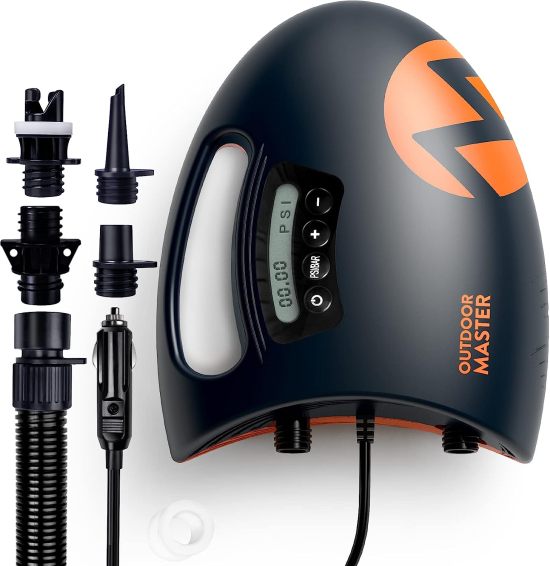
Max PSI: 20 PSI
Power Source: 12V car power
Dimensions: 12.48 x 10.55 x 7.24 inches (31.7 x 26.8 x 18.4 cm)
Warranty: 2 years
The OutdoorMaster Shark II is built to do it all! It has both inflate and deflate settings, a variety of nozzles compatible with literally every type of inflatable, and programmable settings and an auto-shutoff feature that lets you “set it and forget it”.
I put this pump to the test (you can read the results here) and it proved itself wonderfully reliable. With a fill time of around 12 minutes for a 11’ SUP, safety features like a 12amp fuse to avoid damaging your car, and “Active Frost Cooling System” to prevent it overheating, it delivers solid performance for a fairly reasonable price.
If I had one complaint, it’s that the pump is on the larger, heavier side—much too big to pack into one of my SUP backpacks. I have to haul it around in the box or repurpose an old backpack to transport it. At 3.6 pounds, it’s one of the chunkiest, bulkiest of the SUP pumps I’ve tested (except for the OutdoorMaster Whale).
Honorable Mention: Aquaglide Accelerator
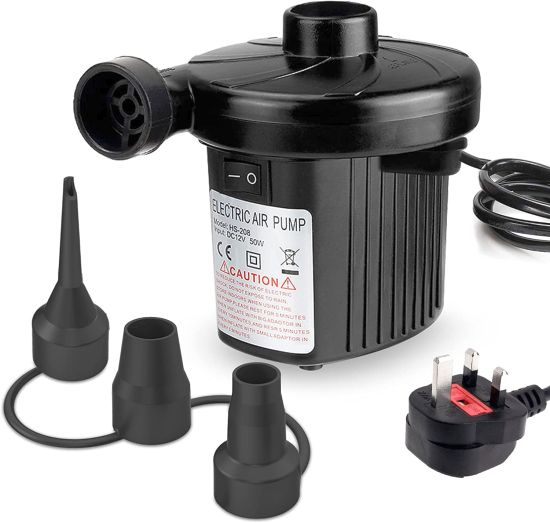
Max PSI: 20 PSI
Power Source: 12V DC car connector
Dimensions: 10.4 x 7.3 x 6.5 inches (26.4 x 18.5 x 16.5 cm)
Warranty: None specified
What makes this particular pump worth including on this list is its reliability. I’ve used it for 3+ years now, and though it’s small, it’s a workhorse that just keeps working.
It’s pretty average in terms of performance—max 20 PSI, inflation speed of around 13 minutes to fill my 11’6” SUP, no cooling system so you can only run it for about 20-30 minutes before you need to shut it off, and auto shut-off controls—but it’s withstood my rough-and-rugged handling for years, even survived rain and spills.
It’s got a couple of flaws: I have to hold the hose down to keep it connected, and a number of the user reviews I read spoke of a fuse burning out (suggesting quality control issues). However, it has served me well for years and shows no sign of giving out anytime soon.
Do I Really Need an Electric Pump?
I’ll be honest: “need” is too strong a word for this.
All inflatable SUPs (and some inflatable kayaks) come with hand pumps included in their package. Many are even highly efficient two-way pumps that push air into your SUP/kayak both when you pull up and press down on the handle.
Working hard (which I always do), you can usually inflate your SUP or inflatable kayak within about 10-15 minutes.
However, I like to hit my local lakes, rivers, and beaches with my family. That means not just one or even two, but three or more SUPs and inflatable kayaks (once we had a full flotilla of 10!).
The effort required to inflate multiple SUPs or kayaks is far too much. If I’d actually done all that work myself, I’d be much too tired to get out on the water and enjoy my paddle.
And that’s why I consider electric pumps so game-changing.
You can let the pump do the work of inflating one of the SUPs or kayaks while you work on inflating another. Or, you can do like I do and use the pump’s first stage (high volume air flow) to bring it up to 5 PSI, then pump up the last 10 PSI by hand while the pump is working on inflating the next board.
Trust me: the more SUPs or kayaks you’ve got to inflate, the more you’ll come to appreciate an electric pump.
But even if it’s just you or you and a buddy/partner/spouse hitting the water, it’ll save you a lot of time to have an electric pump.
My wife and I like to hit up a nearby lake in the evening after work. Thanks to our electric pump, it takes just 10 minutes or so to pump up both our SUPs, then we’re out on the water and relaxing.
Time-saving and effort-reducing—you can’t help but love it!
How Are Pumps for Inflatable Kayaks and SUPs Different?
- Budget inflatable kayaks (by brands like Intex, for example) don’t require any specific PSI, they just need to be inflated enough to fill the air chambers and provide rigidity.
- Sturdier inflatable kayaks (by brands like NRS, Sea Eagle, or Advanced Elements) with drop-stitched floors usually need to be brought up to 8 to 10 PSI for the floor and around 2.5 PSI for the sides.
- Inflatable SUPs need to be filled up to anywhere from 13 to 20 PSI.
For budget kayaks, you can use pretty much any electric pump—for example, the sorts of pump you use to inflate air mattresses—because there is minimal air pressure required, only air volume (see the “Pressure Range” section below for a fuller explanation).
However, for the better-quality inflatable kayaks and all inflatable SUPs, you need a pump capable of reaching higher PSIs. You can find some pumps that work in the 10 PSI range (give or take), which are suited to inflatable kayaks. For SUPs, though, you’ll need an electric pump capable of reaching at least 15 PSI, though 20 PSI is better.
Pumps to Avoid for an Inflatable Kayak or SUP
This should go without saying, but I’m going to say it anyway:
- Do not inflate your kayak or SUP with a bike pump. The needle is very likely to puncture the SUP/kayak material.
- Do not inflate your kayak or SUP with an air compressor. Air compressors generate way too much pressure far too quickly. You risk popping the SUP or kayak or damaging its air chambers from within.
If you’re going to inflate your SUP or kayak, make sure to do so using a pump that’s purpose-built for the task!
A Buyer’s Guide to Electric Pumps for SUPs and Inflatable Kayaks: Factors to Consider
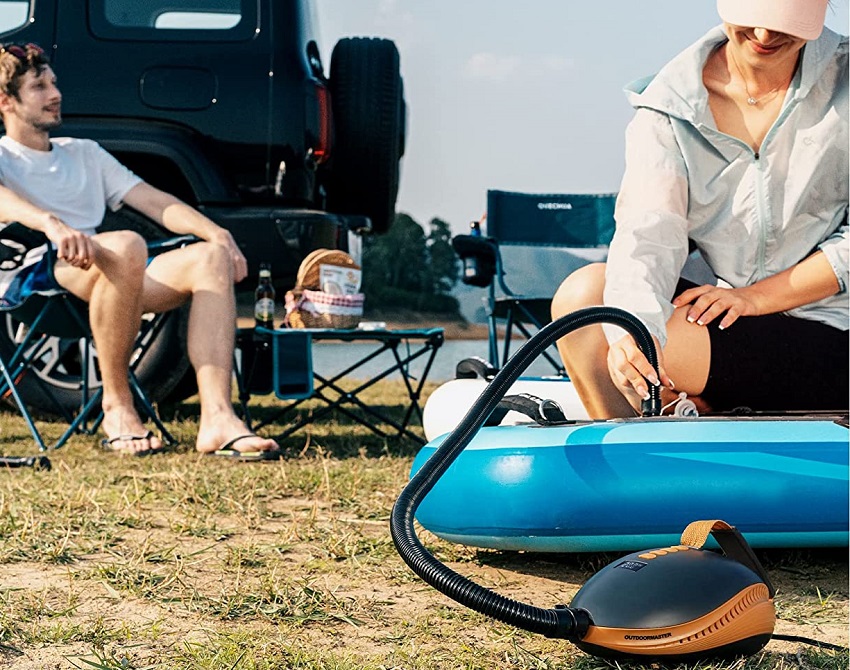
Valve Compatibility
Most SUPs use a type of valve called a “Halkey Roberts valve” or “H-valve”. This is a specialized type of valve that is capable of withstanding a lot more pressure than the standard “Boston valve” or the “Military valve” used in many higher-end inflatable kayaks, and the simpler “pinch valve” used for cheaper inflatables (including kayaks, floating islands, pool toys, etc.).
However, the fact that this valve is different from those used on inflatable kayaks and other inflatables means that your electric pump may not work across the board if it comes with just one valve connector.
Thankfully, most electric pump manufacturers have found a simple workaround: they include multiple connector attachments in the box.
The pumps will usually feature a Halkey Roberts valve-compatible tip connected to the hose because they’re most often used for inflatable SUPs and higher-end inflatable kayaks. However, that connector can be swapped out for other tips that will work with Boston valves, military valves, and pinch valves.
One pump to inflate them all!
Pressure Range
As you saw above, certain types of inflatable need more pressure than others. Inflatable SUPs need a more rigid structure than inflatable kayaks, which means a higher PSI (pounds per square inch) is required.
PSI refers to the amount of pressure inside the chamber. This means a pump has to have power enough to pump in air even under pressure, creating more and more pressure until it reaches the right PSI.
However, initially, when you’re filling the empty kayak or SUP, you want to fill it with a massive amount of volume (air quantity) without worrying too much about the pressure. The pressure only becomes a factor once the air chamber is fully inflated, and you have to force air into that already-full, confined space.
This is why most electric air pumps for kayaks and SUPs feature a “two-stage” design:
Stage 1: High Volume – In this stage, the pump generates a lot of air to quickly fill the empty inflatable kayak/SUP. There is little to no air pressure generated. However, the inflatable is typically brought up to as much as 2 to 3 PSI before it begins to encounter resistance enough to force it to switch to the next stage.
Stage 2: High Pressure – In this stage, the kayak/SUP is “full” of air, which means the pump has to start forcing more and more air into that confined space. The amount of internal pressure (PSI) increases, albeit slowly, because the amount of power required to fill the compressed air into the space is higher than the amount required to fill an “empty” space. Thus, it reaches the higher PSIs far more slowly.
And remember, as I mentioned above:
- Budget inflatable kayaks don’t really need to hit high PSIs, as long as they are sufficiently filled to be rigid.
- Better-quality inflatable kayaks with drop-stitch floors usually need to be brought up to around 8 to 10 PSI for the floor and around 2.5 PSI for the sides.
- SUPs need to hit anywhere from 13 to 20 PSI.
If you’re only going to use the pump for inflatable kayaks, a pump that can hit 10 PSI max is more than enough. But if you plan to fill SUPs as well, you’ll want an electric pump capable of reaching 20 PSI.
Automatic Shut-Off
This is an excellent safety feature to have, one that protects your pump as well as your inflatables.
It takes a lot of power to generate sufficient air pressure to fill your SUP or kayak. Over time, as you fill multiple inflatables, the motor will grow hotter and hotter to the point that it could overheat. Or if forgotten and left alone too long, it could over-fill the board and damage it.
Thankfully, manufacturers typically include an automatic shut-off that turns off the motor before it overheats (harming you or even burning your SUP/kayak). You can also adjust the setting so it shuts off automatically when you reach your desired PSI.
Take my word for it: this is a very important safety and convenience feature to look for in your electric pump.
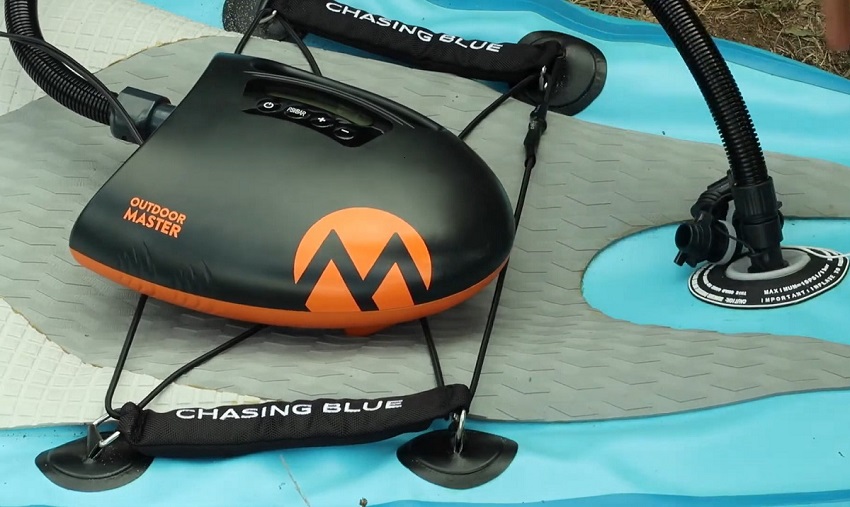
Cooling Requirements
In addition to the safety feature that is the auto shut-off, most electric pumps will have “cooling requirements”. This refers to the amount of time needed to cool off before you can operate the pump again.
Typically, the product description will include details like, “Can inflate X number of SUPs/kayaks” or “Can operate for up to X minutes”. This will tell you roughly how long you’ve got before the auto shut-off kicks in (usually around 10 minutes per SUP).
After that, you’ll see descriptions like “Requires X minutes of cooldown break for every X minute that it runs”. For example, the iRocker Electric Pump I reviewed above needs 30 minutes of cooldown time for every 20 minutes of runtime.
It’s absolutely critical that you give the pump the cool-down time it needs to avoid damaging or breaking it.
Power Supply
There are three basic power supply used by electric pumps:
- 12V car power – This is the most common power supply , given that most inflatable SUPs and kayaks are inflated at lakes, rivers, beaches, and other locations where your car battery is the only easily accessible source of electricity.
- 110V plug – Some (though not many) electric air pumps can be plugged directly into a wall socket. These are typically used in the house (for inflating air mattresses), but there are a few options that are also used for inflatable kayaks and SUPs.
- Battery-powered – This is a very cool type of pump that has really only become available in the last few years, thanks to improvements in lithium-ion battery technology. Power will vary on these devices, and you may only have charge enough for 1-2 SUPs/kayaks. However, they can be a great choice if you’re hiking your SUP or kayak any serious distance (for example, to a mountain-top lake or remote river) and want a power source to take with you.
Deflate Setting
Inflating the kayak or SUP will always be the hardest part of the process, which is why more electric air pumps focus primarily on how much air volume and pressure can be generated to fill the air chambers as quickly as possible.
But some pumps will also feature a “Deflate” setting that will suck the air out of the SUP (once you’ve let most of it out by pressing the release button in the valve). This is a handy feature to ensure the SUP is fully deflated and thus easier to pack/put away.
Digital Display
The digital display will show you the current PSI, and will make it easy for you to track the fill speed and progress so you know how much longer you need to let it run before the SUP/kayak reaches its target PSI.
Ideally, you want a display that’s visible even in bright light conditions and shows large numbers that are easy to see from a distance. That way, you can keep an eye on the electric pump’s progress even while you’re pumping up another board or unpacking your gear.
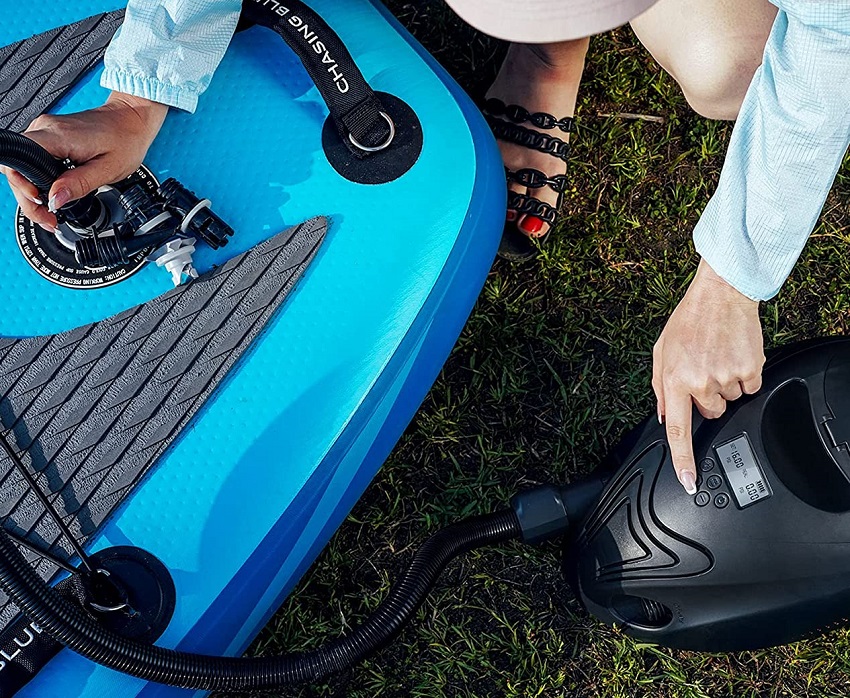
Noise Level
If there’s one thing that can ruin a lovely day at the beach, it’s noise. And not just noisy children or boat motors, but also an electric pump motor working away.
Most retail pages for electric pumps will display the noise level (as marked in decibels, or dBs) of the pump when it kicks on the high-pressure second stage.
For your own sake and the sake of those sharing the water with you, try to find a pump that operates as quietly as possible.
Portability
A good electric pump will be compact enough to fit among your paddling gear—either in your carry tote or even in the side pockets of the SUP/kayak carrying backpack. Thankfully, most of the electric pumps on our list above are roughly the size of a small appliance (waffle maker or toaster).
(Important Note: Bear in mind that a pump that is too small will likely lack the power needed to quickly bring your SUP up to sufficient PSI. It may be worth carrying a slightly larger pump in exchange for more power.)
Hose and Power Cord Length
Regulations require that the power cord of an electric pump be at least 6 feet long. However, the longer the cord, the easier it is to plug the pump into the power source wherever it’s located in the car (beneath the steering wheel, below the dashboard, in the back seat, or even in the trunk).
And a longer hose (4+ feet) makes it easier to connect your pump without having to place the SUP or kayak directly on the hot asphalt next to your car.
Warranty
I’ve had electric pumps that lasted me for 2+ years of regular use, as well as pumps that burned out within 2-3 months.
In the case of those pumps that broke, I was very glad for the warranty provided. The manufacturer sent me a pump to replace the damaged/defective/dead model, and I was able to keep enjoying my summer paddling with no interruptions.
If you’re going to spend good money on a pump, it’s definitely worth making certain it’s backed by a warranty! The longer the warranty, the better the quality of the pump.
Price
Price is always a factor to consider when buying SUP accessories. You want to spend enough to get good-quality products without breaking the bank.
My rule of thumb is simple: any product priced “too good to be true” usually is. You’ll find many cheap “knockoffs” produced abroad by companies who are just looking to move massive amounts of inventory before they disappear. This happens all the time with sellers on Amazon.
Unfortunately, in this case, when the pump inevitably breaks, they’re not backed by a warranty or there’s no longer any way to contact customer support for a company that no longer exists.
That’s why I strongly recommend you pay a bit more to get a pump from a reputable brand that has been around for years (or decades) and you can trust to stand behind the quality of their product.
Electric SUP and Inflatable Kayak Pump FAQs
Paddle board pumps, both electrical and manual, are usually designed to work for all paddle board types. Most modern paddle boards are built using the Halkey Roberts valve, which means pumps can be a “one size fits all” compatible with any paddle board you buy from any brand.
The SUP will clearly state what the “target” or “ideal” PSI should be. Usually, it will be in the range of 13 to 17 PSI.
It absolutely is possible to overinflate a kayak, especially the cheaper ones not rated to hold very high air pressure (PSI). Even the better-quality inflatable kayaks with floors crafted for a range of 8 to 10 PSI can be damaged if you push it past the “maximum” recommended air pressure.
With SUPs, most are rated to inflate up to 20 PSI (though that’s usually a bit higher than recommended), so the risk of damaging them is minimal. Very few air pumps can pass 20 PSI, and you’ll find that trying to fill past 20 PSI is very difficult with a hand pump.
Ideally, you should deflate your SUP or kayak between uses. It’s not harmful to leave them inflated for a few days, but over the long-term, it can compromise the structural integrity of the materials. There’s also greater risk of the SUP or kayak being damaged if transported or stored outside of its carrying case.

